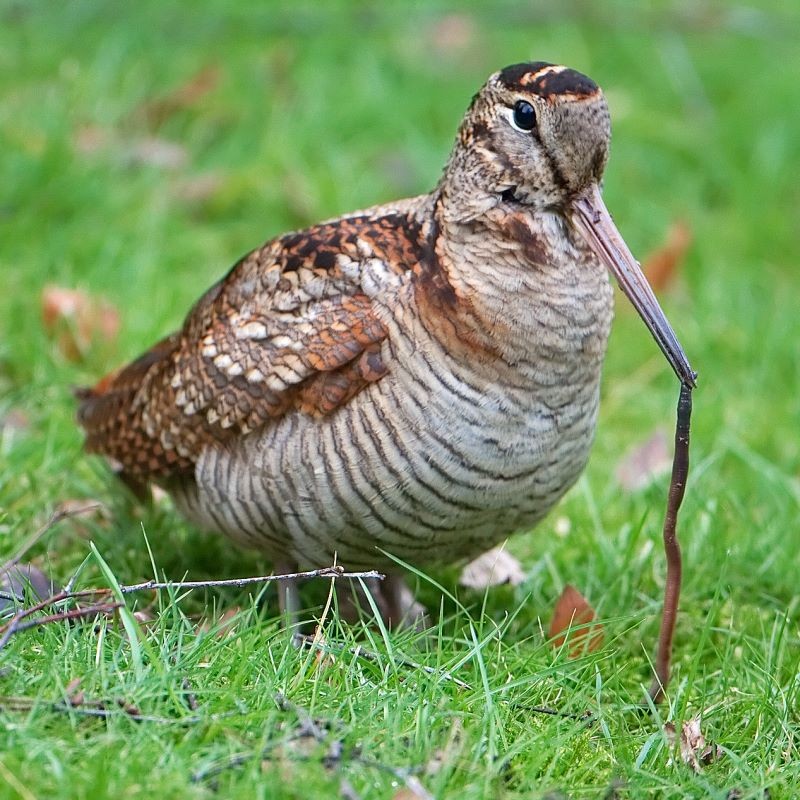Eurasian Woodcock
A species of Woodcocks Scientific name : Scolopax rusticola Genus : Woodcocks
Eurasian Woodcock, A species of Woodcocks
Botanical name: Scolopax rusticola
Genus: Woodcocks
Content
Description General Info
 Photo By Ronald Slabke , used under CC-BY-SA-3.0 /Cropped and compressed from original
Photo By Ronald Slabke , used under CC-BY-SA-3.0 /Cropped and compressed from original Description
Adults are 33–38 cm (13–15 in) in length, including the 6–8 cm (2.4–3.1 in) long straight bill, and have a 55–65 cm (22–26 in) wingspan. The Eurasian woodcock has cryptic camouflage to suit its woodland habitat, with intricately patterned reddish-brown upperparts and buff underparts. The head is barred with black, not striped like that of its close relatives, the snipe. It has large eyes located high on the sides of its head, giving it 360-degree monocular vision. The wings are rounded and the base of the bill is flesh-coloured with a dark tip. The legs vary from grey to pinkish. The species is sexually dimorphic, with the male much larger than the female, although the sexes cannot be separated in the field. 
Size
35 cm
Life Expectancy
21 years
Nest Placement
Ground
Feeding Habits
Eurasian Woodcock primarily feed on earthworms, insects, larvae, freshwater molluscs, and some seeds. They forage nocturnally, probing soft soil in forests and pastures rich in earthworms close to their daytime dense scrub roosts. Cold snaps can force eurasian Woodcock to feed in unusual urban areas for survival.
Habitat
The eurasian Woodcock predominantly inhabits large, undisturbed areas of deciduous or mixed forests across temperate and subarctic Eurasia, characterized by dense underbrush such as brambles and holly. They require a habitat mosaic with dry resting spots, damp feeding grounds, and open spaces for flight. While breeding, they favor moist forests with a mix of scrub undergrowth, often near streams. Seasonally migratory, eurasian Woodcock populations in milder regions remain year-round, adapting to habitats like scrubs and grasslands. Night roosting often occurs in earthworm-rich meadows, reflecting their dietary needs.
Dite type
Omnivorous
General Info
Feeding Habits
Bird food type
Behavior
Eurasian woodcock are crepuscular (most active at dawn and dusk) and rarely active during the day unless flushed, when they fly off with a whirring wing noise. The flight is somewhat owl- or bat-like; woodcock fly fast and directly while migrating or crossing open country, but fly erratically with twisting and fluttering once in woodland. They are usually solitary and migrate singly, but may congregate when weather or geographical conditions force them to do so. This species is parasitised by the moorhen flea, Dasypsyllus gallinulae. 
Distribution Area
About one third of the world's Eurasian woodcock breed in Europe, with more than 90% of the continent's population breeding in Russia and Fennoscandia. Their breeding range stretches from Fennoscandia to the Mediterranean Sea and Canary Islands and from western Europe to Russia. This species is the woodcock found through most of temperate and subarctic Eurasia. Northern and Asian populations migrate to southern Europe or the Indian Subcontinent, respectively. Birds in milder western European countries and on Atlantic islands are resident. The populations breeding in north-west and southern Europe are mostly sedentary. The birds' spring migration commences in February; breeding territories are reached between March and May. Spring migration movements of woodcock are influenced by weather conditions, however this does not have a major effect on their subsequent breeding success. The Eurasian woodcock has a large range, with an estimated Global Extent of Occurrence of 10 million square kilometres and a population of an estimated 15 million to 16 million birds. Because of its large range, stable population trend and large population size, the species has been evaluated as Least Concern. The most important threat to the population of the Eurasian woodcock in the breeding range is the increased fragmentation of its woodland habitat. At other times of year, a reduction in the amount of permanent grassland and an increase in the intensification of farming are also threats, and the species' susceptibility to avian influenza may have an impact in future. The Eurasian woodcock's required breeding habitat is large, unfragmented areas of broadleaved deciduous or mixed broadleaved and coniferous forest, with dense undergrowth of plants such as brambles, holly, hazel, gorse, bracken or bilberry. Breeding territories must include a mix of dry, warm resting places, damp areas for feeding, and clearings for flight. In larger woods, wide 'rides' (open tracks through the wood) and small clearings are important. In winter, Eurasian woodcock also use scrubland during the day but in freezing weather they may use intertidal mud. 
Species Status
Not globally threatened.
Scientific Classification
Phylum
Chordates Class
Birds Order
Shorebirds Family
Sandpipers Genus
Woodcocks Species
Eurasian Woodcock